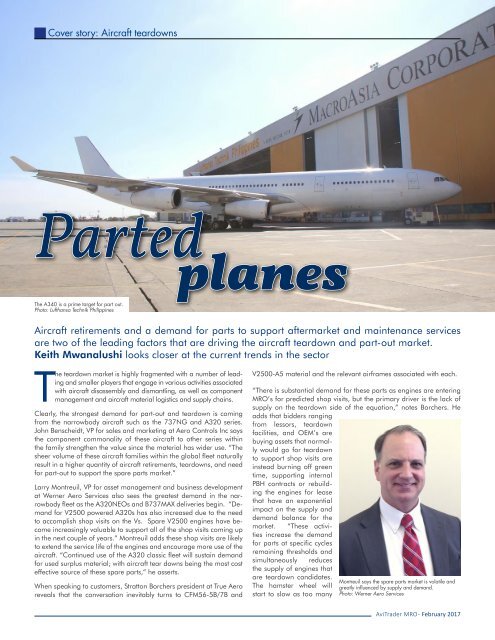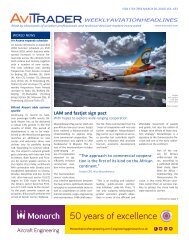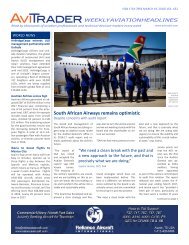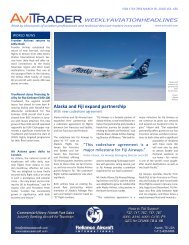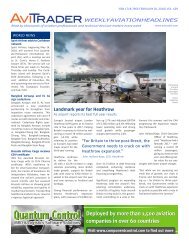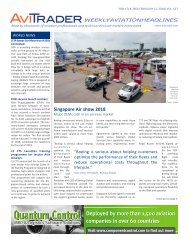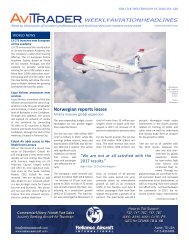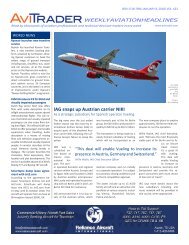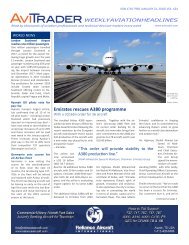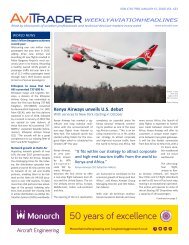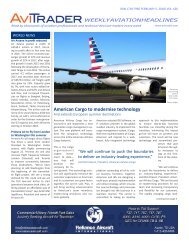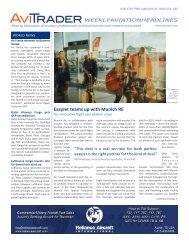AviTrader_Monthly_MRO_e-Magazine_2017-02
AviTrader_Monthly_MRO_e-Magazine_2017-02
AviTrader_Monthly_MRO_e-Magazine_2017-02
Create successful ePaper yourself
Turn your PDF publications into a flip-book with our unique Google optimized e-Paper software.
Cover story: Aircraft teardowns<br />
12<br />
Parted<br />
planes<br />
The A340 is a prime target for part out.<br />
Photo: Lufthansa Technik Philippines<br />
Aircraft retirements and a demand for parts to support aftermarket and maintenance services<br />
are two of the leading factors that are driving the aircraft teardown and part-out market.<br />
Keith Mwanalushi looks closer at the current trends in the sector<br />
T<br />
he teardown market is highly fragmented with a number of leading<br />
and smaller players that engage in various activities associated<br />
with aircraft disassembly and dismantling, as well as component<br />
management and aircraft material logistics and supply chains.<br />
Clearly, the strongest demand for part-out and teardown is coming<br />
from the narrowbody aircraft such as the 737NG and A320 series.<br />
John Benscheidt, VP for sales and marketing at Aero Controls Inc says<br />
the component commonality of these aircraft to other series within<br />
the family strengthen the value since the material has wider use. “The<br />
sheer volume of these aircraft families within the global fleet naturally<br />
result in a higher quantity of aircraft retirements, teardowns, and need<br />
for part-out to support the spare parts market.”<br />
Larry Montreuil, VP for asset management and business development<br />
at Werner Aero Services also sees the greatest demand in the narrowbody<br />
fleet as the A320NEOs and B737MAX deliveries begin. “Demand<br />
for V2500 powered A320s has also increased due to the need<br />
to accomplish shop visits on the Vs. Spare V2500 engines have become<br />
increasingly valuable to support all of the shop visits coming up<br />
in the next couple of years.” Montreuil adds these shop visits are likely<br />
to extend the service life of the engines and encourage more use of the<br />
aircraft. “Continued use of the A320 classic fleet will sustain demand<br />
for used surplus material; with aircraft tear downs being the most cost<br />
effective source of these spare parts,” he asserts.<br />
When speaking to customers, Stratton Borchers president at True Aero<br />
reveals that the conversation inevitably turns to CFM56-5B/7B and<br />
V2500-A5 material and the relevant airframes associated with each.<br />
“There is substantial demand for these parts as engines are entering<br />
<strong>MRO</strong>’s for predicted shop visits, but the primary driver is the lack of<br />
supply on the teardown side of the equation,” notes Borchers. He<br />
adds that bidders ranging<br />
from lessors, teardown<br />
facilities, and OEM’s are<br />
buying assets that normally<br />
would go for teardown<br />
to support shop visits are<br />
instead burning off green<br />
time, supporting internal<br />
PBH contracts or rebuilding<br />
the engines for lease<br />
that have an exponential<br />
impact on the supply and<br />
demand balance for the<br />
market. “These activities<br />
increase the demand<br />
for parts at specific cycles<br />
remaining thresholds and<br />
simultaneously reduces<br />
the supply of engines that<br />
are teardown candidates.<br />
The hamster wheel will<br />
start to slow as too many<br />
Montreuil says the spare parts market is volatile and<br />
greatly influenced by supply and demand.<br />
Photo: Werner Aero Services<br />
<strong>AviTrader</strong> <strong>MRO</strong> - February <strong>2017</strong>


